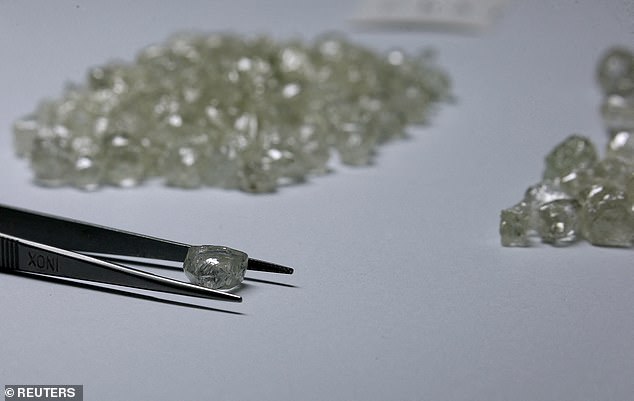Are diamonds yesterday’s status symbol, or can we expect a bullish rebound following the bruising price shock witnessed in 2023?
That’s a tough question to answer, but according to the upper echelons of the diamond-mining industry, there’s cause for optimism.
Take De Beers, the world’s largest miner of these precious – and often controversial – carbon structures.
With natural diamond prices holding their ground against lab-grown alternatives, De Beers sparked hope going into 2024 following the disappointing 2023.
‘We see 2024 as a year of recovery,’ De Beers’ chief executive Al Cook recently said in a Bloomberg TV interview, although ‘we expect that upturn in diamond demand to be gradual rather than sudden’.

Recovery: Are diamonds yesterday’s status symbol, or can we expect a bullish rebound following the bruising price shock witnessed in 2023?
He agreed that 2023 ‘was a very challenging year for the diamond industry’.
Lower demand was driven by a combination of a fall in economic growth, a lag in ‘engagement rates’ in the US and China, and encroachment into the sector by lab-grown diamonds.
However, Cook sees less competition from lab-grown diamonds as status symbols in 2024, given their prices have fallen by more than 90 per cent in just two years.
‘Customers clearly see now that natural diamonds and lab-grown diamonds are two entirely different things,’ he commented.
As John Teeling, chairman of AIM-listed diamond explorer Botswana Diamonds plc put it: ‘A Ferrari and a Ford Mondeo are both good cars but that’s the only commonality they share.’
According to StoneAlgo’s lab-grown diamond price tracker, the average price of a one-carat lab-grown diamond fell over 37 per cent in the past 12 months alone, from more than $1,200 in February 2023 to around $750 today.
In comparison, natural diamonds fell less than 19 per cent, from more than $5,000 for a one-carat diamond in February 2023 to around $4,100 today.
‘The lab-grown diamond market is subject to the same supply/demand imbalances that affect all markets,’ said StoneAlgo.
‘Lab-grown diamond prices are mainly affected by declining costs for growing and manufacturing lab diamonds, increased competition from suppliers, and increased competition from jewellers which has resulted in lower profit margins at the retailer level.’
StoneAlgo said it is unclear whether lab-grown diamond prices will stop falling as the technology for growing diamonds continues to become cheaper and more available, which is driving up competition and driving down lab-grown diamond prices.
Furthermore, lab-grown diamonds offer little in the way of value retention and resale value compared to their natural alternatives.
Even so, De Beers, as the world’s largest diamond miner, is clearly under pricing pressure for one reason or another.
In its first sale of 2024, the group cut prices by 10 per cent in an attempt to stimulate demand.
In essence, the natural diamond industry is suffering the same fate as other discretionary items, with prices overcorrecting steeply following record-breaking luxury goods demand in the Covid-19 lockdown era.
Yet signs of a diamond recovery are emerging.
De Beers’ rough diamond sales of $370million for Cycle 1 (representing sales between 19 December 2023 and 30 January 2024) increased 170 per cent sequentially as a result of US holiday demand and the resumption of sales in India.
You’d be unsurprised to hear that market valuations in the small-cap space are low right now.
Botswana Diamonds is down 60 per cent year on year at 0.45p, while production-stage players Petra Diamonds and Gem Diamonds are down 40 per cent to 46.2p and 70 per cent to 9.98p respectively.
Speaking on the state of the diamond industry, Petra’s chief executive Richard Duffy stated: ‘While we are seeing encouraging indications of price recovery and some stabilisation in the rough diamond market, following actions taken by both producers and the mid-stream, we continue to adopt a cautious approach to the market in the near term.’
Sparking a similar tone, Gem Diamonds observed: ‘The global rough diamond market continued to experience downward pressure in fourth quarter 2023.’
‘There is cautious optimism for 2024 (and) any upswing will transform sentiment,’ Teeling told investors in December.
Recovery is not going to be easy. The funding crunch means explorers are finding it harder to explore, while producers continue to battle price compression.
But if you share a sense of optimism that ‘diamond earnings have troughed’, as Jefferies analysts recently stated, then buying a stake in the industry has not been this cheap for a very long time.
Some links in this article may be affiliate links. If you click on them we may earn a small commission. That helps us fund This Is Money, and keep it free to use. We do not write articles to promote products. We do not allow any commercial relationship to affect our editorial independence.



